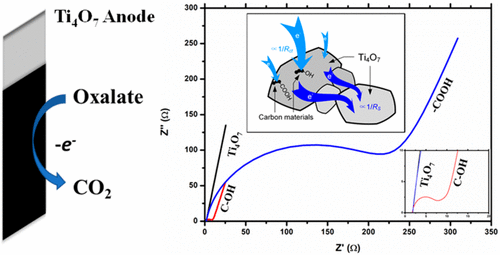当前位置:
X-MOL 学术
›
Environ. Sci. Technol.
›
论文详情
Our official English website, www.x-mol.net, welcomes your feedback! (Note: you will need to create a separate account there.)
Effect of the Presence of Carbon in Ti4O7 Electrodes on Anodic Oxidation of Contaminants.
Environmental Science & Technology ( IF 11.4 ) Pub Date : 2020-04-01 , DOI: 10.1021/acs.est.9b07398 Jiangzhou Xie 1 , Jinxing Ma 1 , Changyong Zhang 1 , Xiangtong Kong 1 , Zhiwei Wang 2 , T David Waite 1, 2, 3
Environmental Science & Technology ( IF 11.4 ) Pub Date : 2020-04-01 , DOI: 10.1021/acs.est.9b07398 Jiangzhou Xie 1 , Jinxing Ma 1 , Changyong Zhang 1 , Xiangtong Kong 1 , Zhiwei Wang 2 , T David Waite 1, 2, 3
Affiliation

|
Magnéli phase titanium suboxide, Ti4O7, has attracted increasing attention as a potential electrode material in anodic oxidation as a result of its high efficiency and (electro)chemical stability. Although carbon materials have been amended to Ti4O7 electrodes to enhance the electrochemical performance or are present as an unwanted residual during the electrode fabrication, there has been no comprehensive investigation of how these carbon materials affect the electrochemical performance of the resultant Ti4O7 electrodes. As such, we investigated the electrochemical properties of Ti4O7 electrodes impregnated with carbon materials at different contents (and chemical states). Results of this study showed that while pure Ti4O7 electrodes exhibited an extremely low rate of interfacial electron transfer, the introduction of minor amounts of carbon materials (at values as low as 0.1 wt %) significantly facilitated the electron transfer process and decreased the oxygen evolution reaction potential. The oxygen-containing functional groups have been shown to play an important role in interfacial electron transfer with moderate oxidation of the carbon groups aiding electron uptake at the electrode surface (and consequently organic oxidation) while the generation of carboxyl groups-a process that is likely to occur in long-term operation-increased the interfacial resistance and thus retarded the oxidation process. Results of this study provide a better understanding of the relationship between the nature of the electrode surface and anodic oxidation performance with these insights likely to facilitate improved electrode design and optimization of operation of anodic oxidation reactors.
中文翻译:

Ti4O7电极中碳的存在对污染物阳极氧化的影响。
镁质相的低价钛氧化物Ti4O7由于其高效率和(电)化学稳定性而作为阳极氧化中的潜在电极材料受到越来越多的关注。尽管碳材料已被修饰成Ti4O7电极以增强电化学性能或在电极制造过程中作为有害残留物存在,但尚未对这些碳材料如何影响所得Ti4O7电极的电化学性能进行全面研究。因此,我们研究了在不同含量(和化学状态)下浸渍有碳材料的Ti4O7电极的电化学性能。这项研究的结果表明,虽然纯Ti4O7电极显示出极低的界面电子转移速率,引入少量的碳材料(含量低至0.1 wt%)显着促进了电子转移过程并降低了氧释放反应的电势。含氧官能团已显示出在界面电子转移中起重要作用,其中碳基团的适度氧化有助于电极表面电子的吸收(以及有机氧化),而羧基的生成可能是一个过程在长期操作中发生,增加了界面电阻,从而延迟了氧化过程。
更新日期:2020-04-23
中文翻译:

Ti4O7电极中碳的存在对污染物阳极氧化的影响。
镁质相的低价钛氧化物Ti4O7由于其高效率和(电)化学稳定性而作为阳极氧化中的潜在电极材料受到越来越多的关注。尽管碳材料已被修饰成Ti4O7电极以增强电化学性能或在电极制造过程中作为有害残留物存在,但尚未对这些碳材料如何影响所得Ti4O7电极的电化学性能进行全面研究。因此,我们研究了在不同含量(和化学状态)下浸渍有碳材料的Ti4O7电极的电化学性能。这项研究的结果表明,虽然纯Ti4O7电极显示出极低的界面电子转移速率,引入少量的碳材料(含量低至0.1 wt%)显着促进了电子转移过程并降低了氧释放反应的电势。含氧官能团已显示出在界面电子转移中起重要作用,其中碳基团的适度氧化有助于电极表面电子的吸收(以及有机氧化),而羧基的生成可能是一个过程在长期操作中发生,增加了界面电阻,从而延迟了氧化过程。



























 京公网安备 11010802027423号
京公网安备 11010802027423号